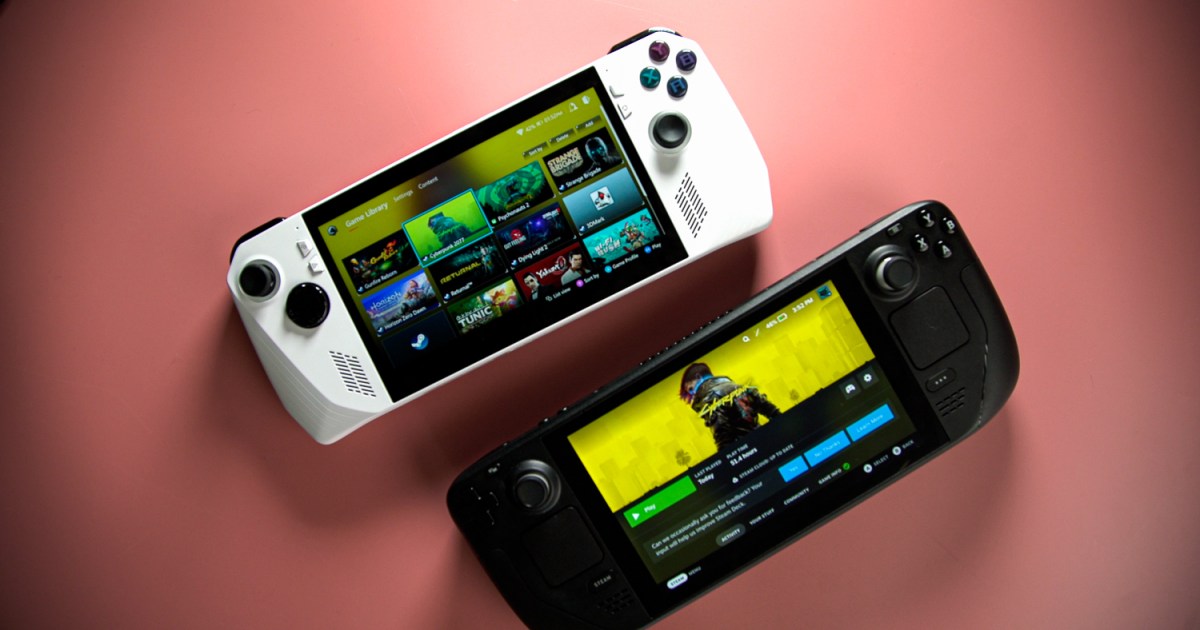It’s been nearly six months since I originally wrote my Asus ROG Ally Z1 Extreme review, and the device has changed drastically in that time. It’s still a compelling device that easily beats the Steam Deck in raw performance, but a slew of strange updates has left the ROG Ally in a strange spot compared to the Steam Deck.
For those who don’t have a handheld gaming PC, the ROG Ally still wins over the Steam Deck. However, as you can read in our Steam Deck review, Valve’s handheld still continues to be a force in the evolving world of gaming handhelds despite its aging hardware.
It’s all a matter of price

Price was the main point in question for the ROG Ally, especially against the aggressively-priced Steam Deck. But it’s clear Asus was ready to fire back at Valve’s handheld with equally aggressive pricing.
The ROG Ally with the Z1 Extreme costs $700. It’s currently available from Best Buy exclusively, and although I was worried it would sell out immediately, it’s still in stock. A cheaper model sporting the Ryzen Z1 is available now, too, priced at $600.
The Steam Deck is as cheap as $349, but that’s only with 64GB of slow storage. To get 512GB, which is what the ROG Ally with the Z1 Extreme has, you’ll need to spend $449. A point in the Steam Deck’s favor, however, is that Valve is now offering refurbished Steam Decks that cut the price as low as $279.
Valve is phasing out the 64GB and 512GB models of the Steam Deck now that the Steam Deck OLED is arriving. Instead, you’ll just have the 256GB model, now at $399. The Steam Deck OLED comes in at these price points: with 512GB of storage for $549 and 1TB of storage for $649. The ROG Ally is faster than the Steam Deck, but now, it’s also significantly more expensive.
Some curious specs

The ROG Ally looks pretty, that’s for sure, but it’s really the underlying hardware that makes Asus’ handheld exciting. The ROG Ally is powered by AMD’s Z1 Series processors, which are custom APUs leveraging Zen 4 CPU cores and RDNA 3 GPU cores. AMD has two of these Z1 processors available, though, and they’re very different.
The Ryzen Z1 comes with six Zen 4 cores and four RDNA 3 cores for a total of up to 2.8 TFLOPS of theoretical performance. The Ryzen Z1 Extreme, by contrast, comes with eight Zen 4 cores and a massive 12 RDNA 3 cores. That enables much higher performance — up to 8.6 TFLOPs, according to AMD.
The ROG Ally was the first device to debut the Z1 Extreme, but there are competitors now. Lenovo’s Legion Go packs a Z1 Extreme, and the Ayaneo 2S uses a Ryzen 7 7840U, which is a rebranded version of the Z1 Extreme.
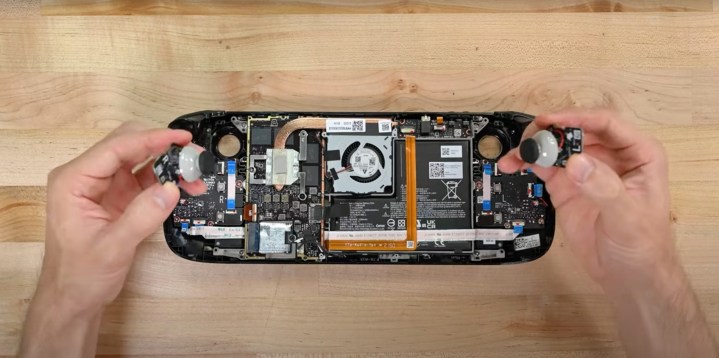
By comparison, the Steam Deck is packing much weaker hardware. Regardless of the model you choose, you’re getting four Zen 2 cores and eight RDNA 2 cores, which offer up to 1.6 TFLOPs of theoretical performance. The Steam Deck’s APU also tops out at 15 watts, while the ROG Ally can go up to 30W in its Turbo mode.
There’s a big difference between the APUs, but the Steam Deck and ROG Ally have some specs in common as well. Both devices come with 16GB of LPDDR5 memory, and they both include a Micro SD card slot for storage expansion. They also both support USB-C for charging and come with a 3.5mm headphone jack.
The Micro SD card is a point of contention. Asus has confirmed that the ROG Ally can cause the Micro SD card to fail under certain thermal conditions. We’ve run one for months without issue, but it’s still an ongoing problem.
A clear performance champ

There’s no question — the ROG Ally with the Z1 Extreme is faster than the Steam Deck. In an apples-to-apples comparison with the same resolution and APU wattage, the ROG Ally is upwards of 50% faster than the Steam Deck. It’s important to note that the ROG Ally can scale higher, too. The Steam Deck tops out at 15W, but the ROG Ally can go up to 30W in its Turbo mode with the charger plugged in.
It was clear from the start that the ROG Ally would be faster, but it comes with a higher-resolution screen, as well. At 1080p, the ROG Ally starts to slip. It’s still a great performer, though, especially when it can run the most demanding games available today at Medium settings while maintaining close to 30 frames per second (fps).
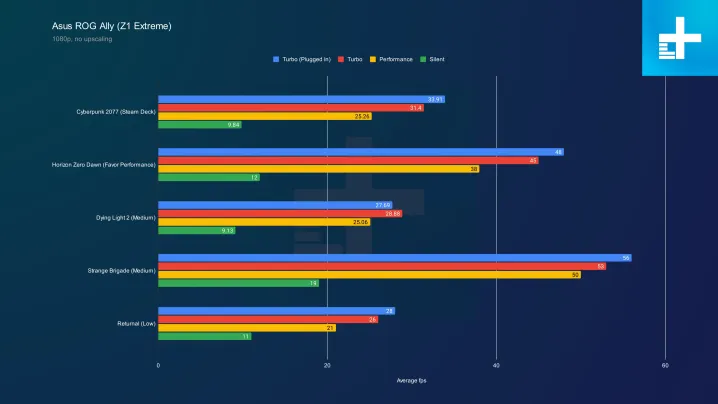
Since release, Asus has released a number of updates for the ROG Ally, and they haven’t improved performance. In fact, performance has regressed. As you can see in our retesting of the device in July, it slips a bit in the comparison to the Steam Deck.

It’s still faster, for sure, but it’s disconcerting to see the ROG Ally slip in performance at the whim of a BIOS update. This update was, apparently, meant to improve performance as well. The previous one was even slower.
Thankfully, there’s some room to improve your performance with different performance modes and upscaling. That’s true for both the ROG Ally and the Steam Deck; the ROG Ally can just go higher. You can run its APU between 7W and 30W, while the Steam Deck only operates between 5W and 15W.
I wouldn’t recommend running the ROG Ally at a full 30W, but it’s nice to have the option if you’re close to a charger and want a boot in performance. Turbo mode isn’t practical on the go, though. It will kill your battery quickly.
The Steam Deck and ROG Ally are pretty close in overall battery life. At the default Performance mode on the ROG Ally and the Steam Deck at full tilt, you can get about two hours of a demanding AAA game. Turbo mode on the ROG Ally is much worse — in my testing, the device died in under an hour.
Overall, though, the ROG Ally feels like a quality upgrade over the Steam Deck, not a performance upgrade. It’s faster and more efficient, but you’ll mainly be running games with better visual quality at a higher resolution while getting similar performance and battery life.
There’s also a point to be made here about how you would use a handheld gaming device. Assuming it’s not your only gaming platform, the Steam Deck can make more sense, even if it’s less powerful. That’s a big reason why I switched back to using my Steam Deck after several months with the ROG Ally.

How about the version with the Ryzen Z1, though? As you can read in our Asus ROG Ally Z1 review, it’s not a great option. Above, you can see that the model with the Ryzen Z1 can’t keep pace with the Steam Deck at 720p with the default Performance mode.
In our testing, the device doesn’t benefit much from higher wattages, either. If you’re considering the Asus ROG Ally with the Ryzen Z1, you should stick with the Steam Deck or spend a little extra on the Z1 Extreme model.
Windows 11 isn’t a done deal
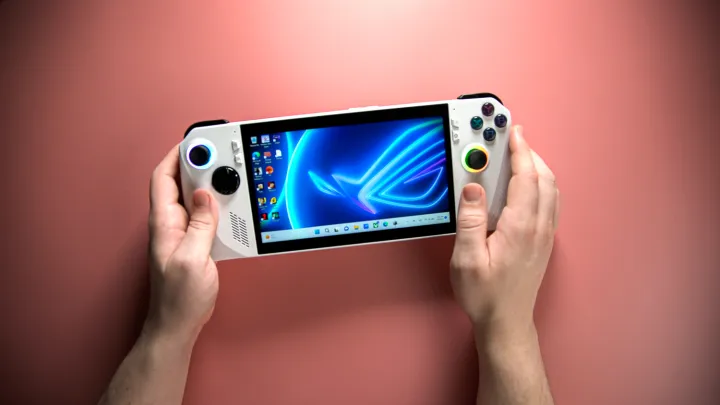
One of the most important differences between the ROG Ally and Steam Deck is the operating system. The Steam Deck uses Valve’s custom SteamOS, while the ROG Ally will leverage Windows 11.
There are pros and cons no matter which way you look. For the Steam Deck, SteamOS provides an easy-to-use, streamlined interface for handheld gaming. It certainly helps that it’s tied into the largest distribution network for PC games, as well, allowing you to easily shop for new titles.
It has myriad problems, though. For starters, SteamOS is still remarkably buggy. For my own Steam Deck, I have to leave Wi-Fi turned off when I’m away from the charger because the handheld will occasionally get confused and think it’s out of battery, even with a full charge. These types of idiosyncrasies are rampant in SteamOS.
For most people, the biggest difference is that SteamOS is built on Linux. That means you’re locked out of playing quite a few games, including those with anti-cheat software and games on other marketplaces (such as the Xbox app). Windows 11 solves that problem for the ROG Ally, allowing you to play games in other storefronts and titles that use anti-cheat software like Destiny 2.
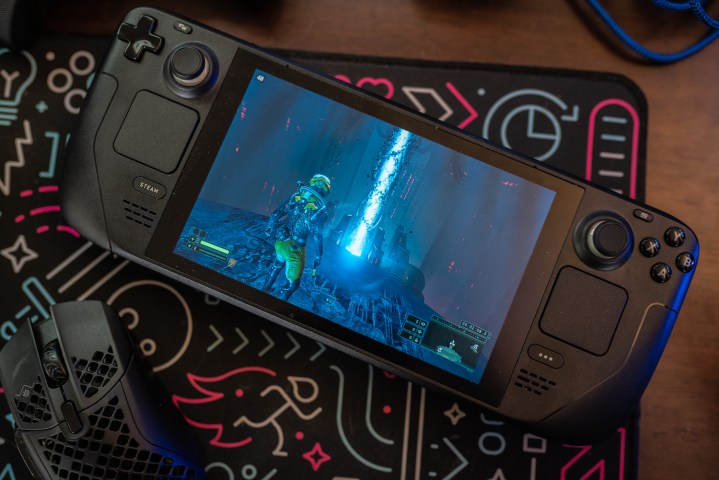
There are some downsides to Windows 11, though. The first is that it’s a desktop operating system, not a handheld gaming one. Instead, Asus’ Armoury Crate runs on top of Windows. It allows you to do things like launch games — it hooks into the EA app, Xbox app, Ubisoft Connect, GOG Galaxy, Epic Games Store, and Steam — and configure settings on the device. But it’s not a one-stop shop.
You have to go to the desktop to install your games, and anything that uses a launcher (such as Cyberpunk 2077) will pull you back to the desktop, as well. Thankfully, the ROG Ally supports two controller modes through Armoury Crate, so you can quickly swap between desktop mode and gaming mode. The application allows you to bind keyboard and mouse commands to buttons, and even attach shortcuts and actions like opening the Task Manager.
The Steam Deck has usability problems, but those mainly come down to strange bugs. The ROG Ally has those issues inherently, and it feels more like a handheld laptop than a handheld console. The Steam Deck wins here, for sure, but there are usability problems regardless.
Fit and finish
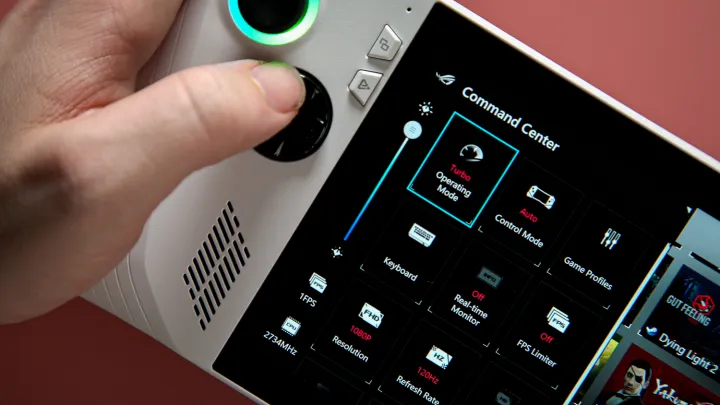
One area where the Steam Deck shoots ahead of the ROG Ally is the feel. It’s big and bulky, but Valve makes good use of that space with quality thumbsticks and buttons, as well as trackpads that can be helpful in games that require a lot of precision.
The ROG Ally doesn’t have trackpads, but the real problem is that its buttons don’t feel as good. The thumbsticks are a little cheap, and the D-pad feels terrible. It’s not as bad as a Joy-Con on a Nintendo Switch, but the ROG Ally definitely feels like a $30 knock-off controller.
However, the ROG Ally is more comfortable to hold. It’s slightly lighter but much smaller. I’m much more comfortable pulling out the ROG Ally on a plane over the Steam Deck; it doesn’t feel nearly as unruly.
The ROG Ally is a winner (with the Z1 Extreme)

The ROG Ally comes with its own problems. It doesn’t immediately solve all the issues of the Steam Deck. But for a higher price, Asus is offering acceptable battery life, better performance, more game support through Xbox Game Pass, and a much nicer screen.
That’s only for the flagship model, though. The base model of the ROG Ally with the Ryzen Z1 is a clear step below the Steam Deck, and it doesn’t have any of the quality-of-life features we see in Valve’s handheld.
That’s even more true now that the Steam Deck OLED is here. Valve is also offering the Steam Deck OLED at a much lower price than the original model, making the Ally look far more expensive by comparison.
Frequently asked questions
Is ROG Ally worth upgrading from Steam Deck?
We’ve found that if you own a Steam Deck, it’s not necessarily worth it at this time to “upgrade” to a ROG Ally, and that’s because the ROG Ally has been given some recent updates that we feel has caused its performance to decline a bit.
How much is the ROG Ally?
At this time the ROG Ally with Z1 Extreme still retails for $700 on the Asus website, but you can currently get it on sale for $600 at Best Buy. The ROG Ally with Ryzen Z1 which normally retails for $600 on the Asus website, is currently being offered by Asus for $400. The current sale price for the ROG Ally Ryzen Z1 at Best Buy is also $400.
How long does the Asus ROG Ally battery last?
During our testing, we found that the battery life of the Asus ROG Ally with Z1 Extreme was as follows:
- Up to five hours of battery life with Silent mode. (But this was with a “less demanding game.”)
- One hour of battery life with Turbo mode.
- Up to two hours of battery life with Performance mode. (This was with a “demanding game.”)
Editors’ Recommendations

